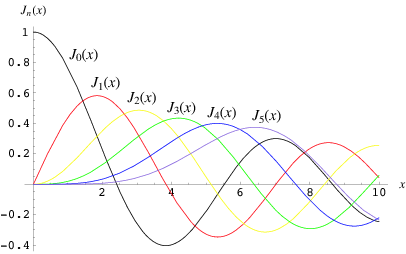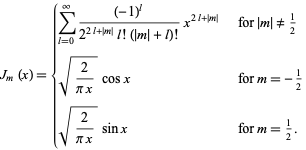Find a General Solution in Terms of Bessel Functions
Bessel Function of the First Kind
![]()
![]()

The Bessel functions of the first kind ![]() are defined as the solutions to the Bessel differential equation
are defined as the solutions to the Bessel differential equation
| | (1) |
which are nonsingular at the origin. They are sometimes also called cylinder functions or cylindrical harmonics. The above plot shows ![]() for
for ![]() , 1, 2, ..., 5. The notation
, 1, 2, ..., 5. The notation ![]() was first used by Hansen (1843) and subsequently by Schlömilch (1857) to denote what is now written
was first used by Hansen (1843) and subsequently by Schlömilch (1857) to denote what is now written ![]() (Watson 1966, p. 14). However, Hansen's definition of the function itself in terms of the generating function
(Watson 1966, p. 14). However, Hansen's definition of the function itself in terms of the generating function
| | (2) |
is the same as the modern one (Watson 1966, p. 14). Bessel used the notation ![]() to denote what is now called the Bessel function of the first kind (Cajori 1993, vol. 2, p. 279).
to denote what is now called the Bessel function of the first kind (Cajori 1993, vol. 2, p. 279).
The Bessel function ![]() can also be defined by the contour integral
can also be defined by the contour integral
| | (3) |
where the contour encloses the origin and is traversed in a counterclockwise direction (Arfken 1985, p. 416).
The Bessel function of the first kind is implemented in the Wolfram Language as BesselJ[nu, z].
To solve the differential equation, apply Frobenius method using a series solution of the form
| | (4) |
Plugging into (1) yields
 | (5) |
 | (6) |
The indicial equation, obtained by setting ![]() , is
, is
| | (7) |
Since ![]() is defined as the first nonzero term,
is defined as the first nonzero term, ![]() , so
, so ![]() . Now, if
. Now, if ![]() ,
,
| | (8) |
| | (9) |
| | (10) |
| | (11) |
First, look at the special case ![]() , then (11) becomes
, then (11) becomes
| | (12) |
so
| | (13) |
Now let ![]() , where
, where ![]() , 2, ....
, 2, ....
| | | | (14) |
| | | | (15) |
| | | | (16) |
which, using the identity ![]() , gives
, gives
| | (17) |
Similarly, letting ![]() ,
,
| | (18) |
which, using the identity ![]() , gives
, gives
| | (19) |
Plugging back into (◇) with ![]() gives
gives
| | | | (20) |
| | | | (21) |
| | | | (22) |
| | | | (23) |
| | | | (24) |
The Bessel functions of order ![]() are therefore defined as
are therefore defined as
so the general solution for ![]() is
is
| | (27) |
Now, consider a general ![]() . Equation (◇) requires
. Equation (◇) requires
| | (28) |
| | (29) |
for ![]() , 3, ..., so
, 3, ..., so
for ![]() , 3, .... Let
, 3, .... Let ![]() , where
, where ![]() , 2, ..., then
, 2, ..., then
where ![]() is the function of
is the function of ![]() and
and ![]() obtained by iterating the recursion relationship down to
obtained by iterating the recursion relationship down to ![]() . Now let
. Now let ![]() , where
, where ![]() , 2, ..., so
, 2, ..., so
| | | | (34) |
| | | | (35) |
| | | | (36) |
Plugging back into (◇),
| | | | (37) |
| | | | (38) |
| | | | (39) |
| | | | (40) |
| | | | (41) |
Now define
| | (42) |
where the factorials can be generalized to gamma functions for nonintegral ![]() . The above equation then becomes
. The above equation then becomes
| | (43) |
Returning to equation (◇) and examining the case ![]() ,
,
| | (44) |
However, the sign of ![]() is arbitrary, so the solutions must be the same for
is arbitrary, so the solutions must be the same for ![]() and
and ![]() . We are therefore free to replace
. We are therefore free to replace ![]() with
with ![]() , so
, so
| | (45) |
and we obtain the same solutions as before, but with ![]() replaced by
replaced by ![]() .
.
 | (46) |
We can relate ![]() and
and ![]() (when
(when ![]() is an integer) by writing
is an integer) by writing
| | (47) |
Now let ![]() . Then
. Then
But ![]() for
for ![]() , so the denominator is infinite and the terms on the left are zero. We therefore have
, so the denominator is infinite and the terms on the left are zero. We therefore have
Note that the Bessel differential equation is second-order, so there must be two linearly independent solutions. We have found both only for ![]() . For a general nonintegral order, the independent solutions are
. For a general nonintegral order, the independent solutions are ![]() and
and ![]() . When
. When ![]() is an integer, the general (real) solution is of the form
is an integer, the general (real) solution is of the form
| | (52) |
where ![]() is a Bessel function of the first kind,
is a Bessel function of the first kind, ![]() (a.k.a.
(a.k.a. ![]() ) is the Bessel function of the second kind (a.k.a. Neumann function or Weber function), and
) is the Bessel function of the second kind (a.k.a. Neumann function or Weber function), and ![]() and
and ![]() are constants. Complex solutions are given by the Hankel functions (a.k.a. Bessel functions of the third kind).
are constants. Complex solutions are given by the Hankel functions (a.k.a. Bessel functions of the third kind).
The Bessel functions are orthogonal in ![]() according to
according to
| | (53) |
where ![]() is the
is the ![]() th zero of
th zero of ![]() and
and ![]() is the Kronecker delta (Arfken 1985, p. 592).
is the Kronecker delta (Arfken 1985, p. 592).
Except when ![]() is a negative integer,
is a negative integer,
| | (54) |
where ![]() is the gamma function and
is the gamma function and ![]() is a Whittaker function.
is a Whittaker function.
In terms of a confluent hypergeometric function of the first kind, the Bessel function is written
| | (55) |
A derivative identity for expressing higher order Bessel functions in terms of ![]() is
is
| | (56) |
where ![]() is a Chebyshev polynomial of the first kind. Asymptotic forms for the Bessel functions are
is a Chebyshev polynomial of the first kind. Asymptotic forms for the Bessel functions are
| | (57) |
for ![]() and
and
| | (58) |
for ![]() (correcting the condition of Abramowitz and Stegun 1972, p. 364).
(correcting the condition of Abramowitz and Stegun 1972, p. 364).
A derivative identity is
| | (59) |
An integral identity is
| | (60) |
Some sum identities are
| | (61) |
(which follows from the generating function (◇) with ![]() ),
),
| | (62) |
(Abramowitz and Stegun 1972, p. 363),
| | (63) |
(Abramowitz and Stegun 1972, p. 361),
| | (64) |
for ![]() (Abramowitz and Stegun 1972, p. 361),
(Abramowitz and Stegun 1972, p. 361),
| | (65) |
(Abramowitz and Stegun 1972, p. 361), and the Jacobi-Anger expansion
| | (66) |
which can also be written
| | (67) |
The Bessel function addition theorem states
| | (68) |
Various integrals can be expressed in terms of Bessel functions
| | (69) |
which is Bessel's first integral,
for ![]() , 2, ...,
, 2, ...,
| | (72) |
for ![]() , 2, ...,
, 2, ...,
| | (73) |
for ![]() . The Bessel functions are normalized so that
. The Bessel functions are normalized so that
| | (74) |
for positive integral (and real) ![]() . Integrals involving
. Integrals involving ![]() include
include
| | (75) |
| | (76) |
Ratios of Bessel functions of the first kind have continued fraction
 | (77) |
(Wall 1948, p. 349).


The special case of ![]() gives
gives ![]() as the series
as the series
 | (78) |
(Abramowitz and Stegun 1972, p. 360), or the integral
| | (79) |
Wolfram Web Resources
| Mathematica » The #1 tool for creating Demonstrations and anything technical. | Wolfram|Alpha » Explore anything with the first computational knowledge engine. | Wolfram Demonstrations Project » Explore thousands of free applications across science, mathematics, engineering, technology, business, art, finance, social sciences, and more. |
| Computerbasedmath.org » Join the initiative for modernizing math education. | Online Integral Calculator » Solve integrals with Wolfram|Alpha. | Step-by-step Solutions » Walk through homework problems step-by-step from beginning to end. Hints help you try the next step on your own. |
| Wolfram Problem Generator » Unlimited random practice problems and answers with built-in Step-by-step solutions. Practice online or make a printable study sheet. | Wolfram Education Portal » Collection of teaching and learning tools built by Wolfram education experts: dynamic textbook, lesson plans, widgets, interactive Demonstrations, and more. | Wolfram Language » Knowledge-based programming for everyone. |
Find a General Solution in Terms of Bessel Functions
Source: https://mathworld.wolfram.com/BesselFunctionoftheFirstKind.html